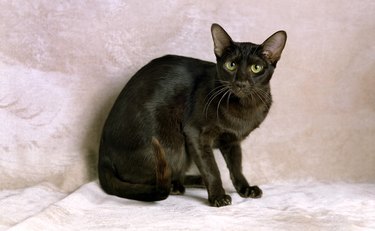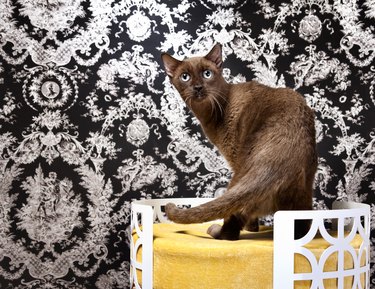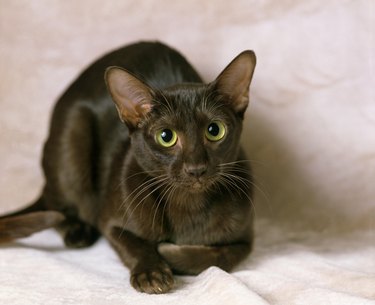
Havana brown cat quick facts
Length: 12 - 16 inches
Weight: Females: 6 - 8 pounds, Males: 8 - 10 pounds
Video of the Day
Video of the Day
Lifespan: 8 - 13 years or more
Coat length: Short
Coloring: Brown with green eyes
Grooming needs: Low
Friendliness: Breed alone is not an accurate predictor of individual cats' personalities. However, Havana brown cats are generally regarded as intelligent, inquisitive, and affectionate.
The Havana brown breed of cat, sometimes referred to as chocolate delight, is a stunning and unique cat. This shorthair cat has a brown coat color and green eyes. The Havana brown may have been named after the Havana rabbit breed of the same color, or perhaps after Havana cigars from Cuba. Regardless of where they got their name, this medium-sized cat has a delightful personality. They are likely to charm every member of your household. Consider the breed's personality and care requirements before deciding if the Havana brown is right for you.

Havana brown cat history
Records from the late 19th century show that brown cats, sometimes called Swiss mountain cats, were shown at cat shows in England. Unfortunately, the British Siamese Cat Club stopped allowing the beautiful brown cats to compete in cat shows.
The Havana brown cat breed that is known today originated in England as a cross between domestic black cats and seal point and chocolate point Siamese cats. There was also some outcrossing with Russian blue cats to create the self-chocolate or self-brown cats. The first cat to be registered as a Havana cat was a cat named Elmtower Bronze Idol.
In 1958, the Governing Council of the Cat Fancy (GCCF) recognized the new Havana cat breed, which at the time was called chestnut foreign shorthair. In the 1950s, the first Havana cats were brought to North America, where cat breeders continued to develop the breed.
In 1964, the Cat Fanciers' Association (CFA) granted the Havana brown breed championship status. The International Cat Association (TICA) also recognizes the Havana cat. However, the international association also allows the lilac color in addition to brown.
In England, the Havana cat breed is built more like the Oriental shorthair or Siamese cat breed. North American Havana brown cats have a different appearance that is more similar to the foundation cats first brought over from England. They have large ears and a head shape that is longer than it is wide. Besides the brown coat, the breed standard calls for brown whiskers and brown, rosy-toned nose leather.
Havana brown cat personality
Havana brown cats are outgoing and affectionate. They enjoy interacting with you. Whether that be playing with a teaser toy or napping while you enjoy a book or a movie. This is not a good breed if you live alone and are rarely home. Fortunately, the Havana brown loves spending time with human family members. They also tend to get along well with other cats and dogs in the household.
The breed has a moderate energy level, and it isn't uncommon for a Havana brown to zoom around the house. Of course, they also love to relax and nap, preferably close to you. The cats are very intelligent and, with a bit of patience and positive reinforcement, you can teach them tricks. Interactive toys, such as puzzle toys, can help to satisfy their inquisitive nature.
As with their Siamese ancestors, Havana brown cats can be vocal at times, although they have a softer meow. They aren't usually too demanding and are just as likely to reach out and touch you with their paw to get your attention.

Havana brown cat lifespan and health issues
A healthy Havana brown cat can live 13 years or more with excellent care. The breed rarely suffers from genetic health problems, but there are some conditions that may affect the breed. In rare cases, kittens will be born with hemophilia, a condition that prevents blood from clotting properly. Be sure to discuss the health of your kitten and their parents with the breeder.
In addition, some Havana brown cats are more prone to developing respiratory and urinary tract infections. Of course, these are conditions that can affect cats of any breed.
Havana brown cat grooming and care
Havana brown cats are easy to groom. They have a silky, short coat, and tangles and matting are not generally a concern. Brush the coat weekly with a soft rubber brush to remove any loose fur. Then, run a cloth made of silk or soft chamois over the cat to bring out the shine in their coat. Bathing isn't necessary, but make sure you take time to:
- clean the cat's ears
- check and trim their nails
- brush the cat's teeth with a toothpaste that is veterinarian-approved for cats
Feed high-quality cat food as recommended by your veterinarian and provide fresh water at all times. Take your cat for regular veterinary check-ups and make sure they get all the recommended vaccinations.

Welcoming a new cat into your home
Before bringing your new Havana brown kitten or cat into your home, take some time to cat-proof the home to make sure the environment is safe. Initially, it is best to keep your cat in a single room where they can adapt to the new environment. Set up the room with everything your new cat may need including:
- litter box
- cat food and water
- scratching post
- cat tree
- toys
Spend plenty of time with your new cat. The breed tends to be outgoing and people-oriented, so they'll likely warm up to you pretty quickly. Be patient, as some cats may take longer than others to adjust. Use plenty of positive reinforcement and allow the cat to come to you when they are ready. Don't force them to be held or petted before they are comfortable.
This is also a good time to introduce your new cat to any other pets in the household. This ensures the experience is positive for everyone and your cat can retreat to the safe room if they get overwhelmed.
Once your cat is comfortable, you can open up the door and allow them access to more of the house. Before you know it, your Havana brown will be a loving companion and an active participant in your daily life.